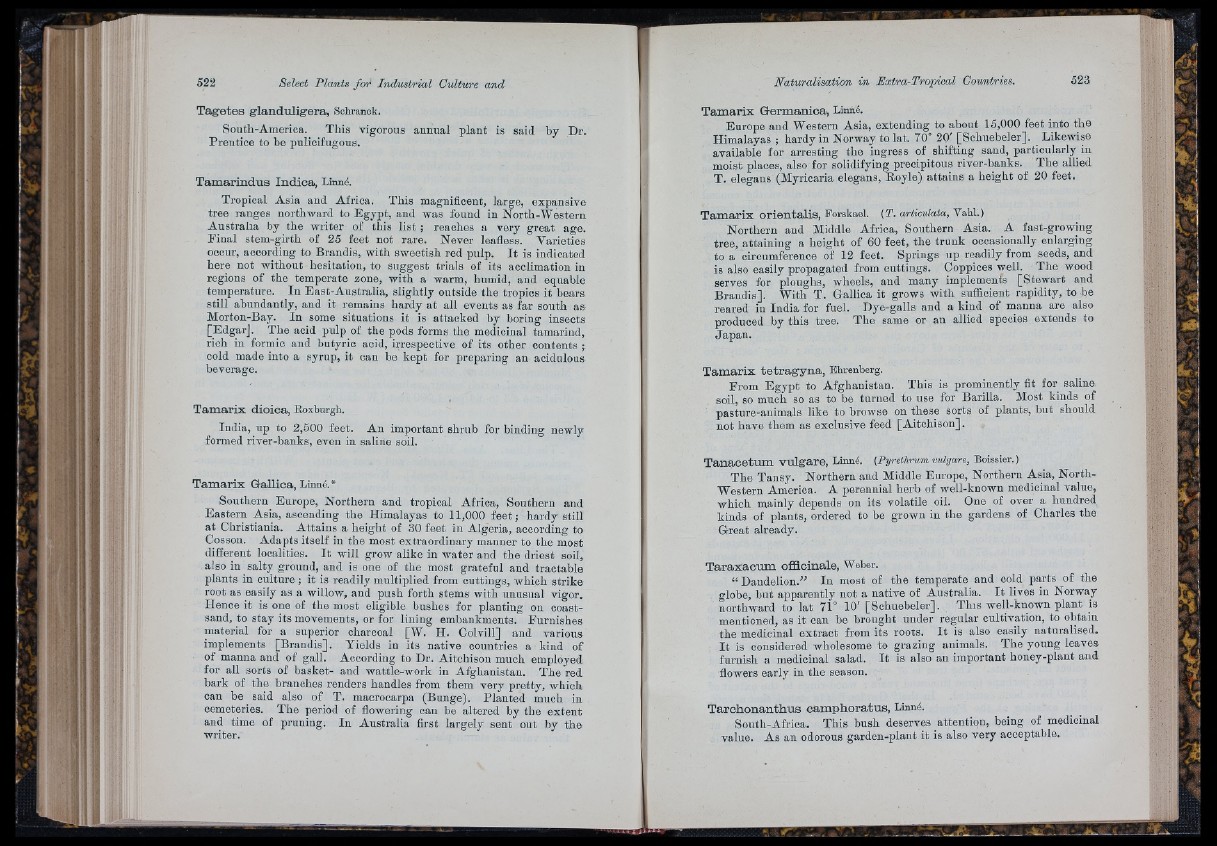
T a g e te s g la n d tilig e ra , Sohranck.
Soutli-America. This vigorous annual plant is said hy Dr.
Prentice to be pulicifugous.
T am a r in d u s In d ic a , Linné.
Tropical Asia and Africa. This magnificent, large, expansive
tree ranges northward to Egypt, and was found in North-Western
Australia by the writer of this list ; reaches a very great age.
Final stem-girth of 25 feet not rare. Never leafless. Varieties
occur, according to Brandis, with sweetish red pulp. I t is indicated
here not without hesitation, to suggest trials of its acclimation in
regions of the temperate zone, with a warm, humid, and equable
temperature. In East-Australia, slightly outside the tropics it bears
still abundantly, aud it remains hardy a t all events as far south as
Morton-Bay. In some situations it is attacked by boring insects
[Edgar]. The acid pulp of the pods forms the medioinal tamarind,
rich in formic and butyric acid, irrespective of its other contents
cold made into a syrup, it ean be kept for preparing an acidulous
T am a r ix dioica, Roxburgh.
India, up to 2,500 feet. An important shrub for binding newly
formed river-banks, even in saline soil.
T am a r ix Gallica, Linné.*
Southern Europe, Northern and tropical Africa, Southern and
Eastern Asia, ascending the Himalayas to 11,000 fe e t; hardy still
at Christiania. Attains a height of 30 feet in Algeria, according to
Cosson. Adapts itself in the most extraordinary manner to the most
different localities. I t will grow alike in water aud the driest soil,
also iu salty ground, and is one of the most grateful aud tractable
plants in culture ; it is readily multiplied from cuttings, which strike
root as easily as a willow, and push forth stems with unusual vigor.
Hence it is one of the most eligible hushes for planting ou coast-
sand, to stay its movements, or for lining embankments. Furnishes
material for a superior charcoal [W. H. Colvill] and various
implements [Brandis], Yields in its native countries a kind of
of manna and of gall. According to Dr. Aitchison much employed
for all sorts of basket- and wattle-work in Afghanistan. The red
bark of the branches renders handles from them very pretty, which
can be said also of T. macrocarpa (Bunge). Planted much in
cemeteries. The period of flowering can be altered by the extent
and time of pruning. In Australia first largely sent out by the
writer.
T am a r ix G e rm an io a , Linnó.
Europe and Western Asia, extending to about 15,000 feet into the
Himalayas ; hardy in Norway to lat. 70° 20' [Schuebeler]. ^ Likewise
available for arresting the ingress of shifting sand, particularly in
moist places, also for solidifying precipitous river-banks. The alhed
T. elegans (Myricaria elegans, Royle) attains a height of 20 feet.
T am a r ix o r ie n ta lis , Forskael. (T. artieulata, Vahl.)
Northern and Middle Africa, Southern Asia. A fast-growing
tree, attaining a height of 60 feet, the trunk occasionally enlarging
to a circumference of 12 feet. Springs up readily from seeds, and
is also easily propagated from cuttings. Coppices well. The wood
serves for ploughs, wheels, and many implements [Stewart and
Brandis]. With T. Gallica it grows with sufficient rapidity, to be
reared in India for fuel. Dye-galls and a kind of manna are also
produced by this tree. The same or an allied species extends to
Japan.
T am a r ix te t r a g y n a , Ehrenberg.
From Egypt to Afghanistan. This is prominently fit for saline
soil, so much so as to be turned to use for Barilla. Most kinds of
pasture-animals like to browse on these sorts of plants, but should
not have them as exclusive feed [Aitchison].
T a n a c e tum v u lg a re , Linné. (Pyrethrum vulgäre, Boissier.)
The Tansy. Northern and Middle Europe, Northern Asia, North-
Western America. A perennial herb of well-known medicinal value,
which mainly depends on its volatile oil. One of over a hundred
kinds of plants, ordered to he grown in the gardens of Charles the
Great already.
T a r a x a c um offloinale, Weber.
“ Dandelion.” In most of the temperate and cold parts of the
globe, but apparently not a native of Australia. I t lives in Norway
northward to lat 71° 10' [Schuebeler]. This well-known plant is
mentioned, as it can he brought under regular cultivation, to obtain
the medicinal extract from its roots. I t is also easily naturalised.
I t is considered wholesome to grazing animals. The young leaves
furnish a medicinal salad. I t is also an important honey-plant and
flowers early in the season.
T a ro h o n a n th u s c am p h o r a tu s , Linné.
South-Africa. This bush deserves attention, being of medicinal
value. As an odorous garden-plant it is also very acceptable.